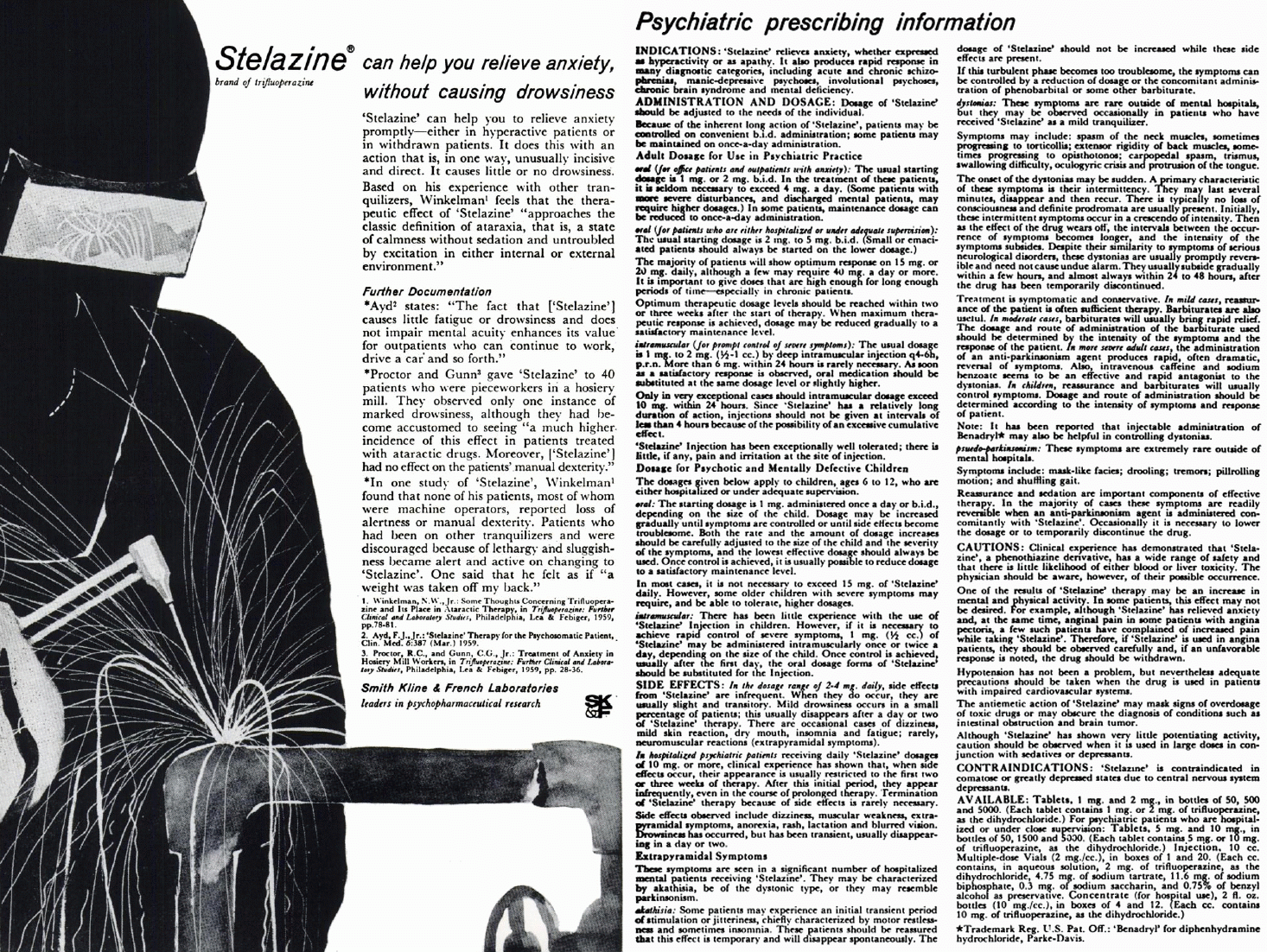

|
|
Stelazine advertisement, 1961. Psychosomatics, Vol. 2, No. 3. Stelazine® brand of trifluoperazine HCl can help you relieve anxiety, without causing drowsiness 'Stelazine' can help you to relieve anxiety promptly -- either in hyperactive patients or in withdrawn patients. It does this with an action that is, in one way, unusually incisive and direct. It causes little or no drowsiness. Based on his experience with other tranquilizers, Winkelman(1) feels that the therapeutic effect of 'Stelazine' "approaches the classic definition of ataraxia, that is, a state of calmness without sedation and untroubled by excitation in either internal or external environment." Further documentation: * Ayd(2) states: "The fact that ['Stelazine'] causes little fatigue or drowsiness and does not impair mental acuity enhances its value for outpatients who can continue to work, drive a car and so forth." * Proctor and Gunn(3) gave 'Stelazine' to 40 patients who were pieceworkers in a hosiery mill. They observed only one instance of marked drowsiness, although they had become accustomed to seeing "a much higher incidence of this effect in patients treated with ataractic drugs. Moreover, ['Stelazine'] had no effect on the patients' manual dexterity." * In one study of 'Stelazine', Winkelman(1) found that none of his patients, most of whom were machine operators, reported loss of alertness or manual dexterity. Patients who had been on other tranquilizers and were discouraged because of lethargy and sluggishness became alert and active on changing to 'stelazine'. One said that he felt as if "a weight was taken off my back." 1. Winkelman, N.W., Jr.: Some Thoughts Concerning Trifluoperazine and Its Place in Ataractic Therapy, in Trifluoperazine: Further Clinical and Laboratory Studies, Philadelphia, Lea 7 Febiger, 1959, pp. 78-81. 2. Ayd, F.J., Jr.: 'Stelazine' Therapy for the Psychosomatic Patient, Clin. Med. 6:387 (mar.) 1959. 3. Proctor, R.C., and Gunn, C.G., Jr.: Treatment of Anxiety in Hosiery Mill Workers, in Trifluoperazine: Further Clinical and Laboratory Studies, Philadelphia, Lea 7 Febiger, 1959, pp. 28-36. Smith Kline & French Laboratories leaders in psychopharmaceutical research | Psychiatric Prescribing Information Extrapyramidal Symptoms These symptoms are seen in a significant number of hospitalized mental patients receiving 'Stelazine'. They may be characterized by akathisia, be of the dystonic type, or they may resemble parkinsonism. akathisia: Some patients may experience an initial transient period of stimulation or jitteriness, chiefly characterized by motor restlessness and sometimes insomnia. These patients should be reassured that this effect is temporary and will disappear spontaneously. The dosage of 'Stelazine' should not be increased while these side effects are present. If this turbulent phase becomes too troublesome, the symptoms can be controlled by a reduction of dosage or the concomitant administration of phenobarbital or some other barbiturate. dystonias: These symptoms are rare outside of mental hospitals, but they may be observed occasionally in patients who have received 'Stelazine' as a mild tranquilizer. Symptoms may include: spasm of the neck muscles, sometimes progressing to torticollis; extensor rigidity of back muscles, sometimes progressing to opisthotonos; carpopedal spasm, trismus, swallowing difficulty, oculogyric crisis and protrusion of the tongue. The onset of dystonias may be sudden. A primary characteristic of these symptoms is their intermittency. They may last several minutes, disappear and then recur. There is typically no loss of consciousness and definite prodromata are usually present. Initially, these intermittent symptoms occur in a crescendo of intensity. Then as the effect of the drug wears off, the intervals between the occurrence of symptoms become longer, and the intensity of the symptoms subsides. Despite their similarity to symptoms of serious neurological disorders, these dystonia are usually promptly reversible and need not cause undue alarm. They usually subside gradually within a few hours, and almost always within 24 to 48 hours, after the drug has been temporarily discontinued. Treatment is symptomatic and conservative. In mild cases, reassurance of the patient is often sufficient therapy. Barbiturates are also useful. In moderate cases, barbiturates will usually bring rapid relief. The dosage and route of administration of the barbiturate used should be determined by the intensity of the symptoms and the response of the patient. In more severe adult cases, the administration of an anti-parkinsonism agent produces rapid, often dramatic, reversal of symptoms. Also, intravenous caffeine and sodium benzoate seems to be an effective and rapid antagonist to the dystonias. In children, reassurance and barbiturates will usually control symptoms. Dosage and route of administration should be determined according to the intensity of symptoms and response of patient. Note: It has been reported that injectable administration of Benadryl may also be helpful in controlling dystonias. pseudo-parkinsonism: These symptoms are extremely rare outside of mental hospitals. Symptoms include: mask-like facies; drooling; tremors; pillrolling motion; and shuffling gait. Reassurance and sedation are important components of effective therapy. In the majority of cases these symptoms are readily reversible when an anti-parkinsonism agent is administered concomitantly with 'Stelazine'. Occasionally it is necessary to lower the dosage or to temporarily discontinue the drug. SK&F |